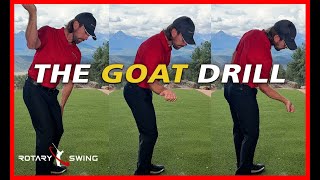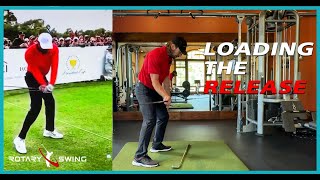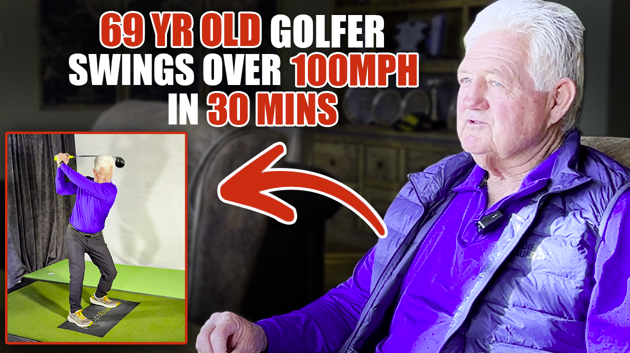Do you tend to get "stuck" in the downswing?
Do you hit blocks and quick hooks?
Do you want to get the ball to start on your intended target line and stay there?
Improper and overly aggressive use of the body is typically what you are going to need to overcome.
In this video, I give you a simple drill and very important fundamental for the arms that you can work on both at your club and at home to start hitting perfectly straight shots.
Not only will this drill teach you to hit the ball straighter, but also further and with much less effort!
While this video is targeted towards the golfer who tends to get stuck, it is also critical for golfers of all levels to learn how to get and keep the club on plane during the downswing.
Read below to learn how to "spin the shaft" and "trace the plane line" to start puring the ball!
There are two critical components to this drill.
First, you need something similar to our Tour Sticks (learn more by clicking here: Tour Sticks) to be stuck in the ground.
Alternatively, you can use a training aid similar to what I am using here called "The Path Pro."
Regardless of what you are using, it needs to be setup parallel to the shaft at address and slightly to the inside, as seen in the image below.
This ensures that the club has room to swing without hitting the training aid.
Once setup, you want to begin making very slow motion swings performing the "spin the shaft" movement described in the video. Note that both hands are involved for this movement, even though I primarily focus on discussing the movement of the right arm in the video.
Using your Tour Stick or training aid as a guide, you want to trace down it while rotating the club shaft so that the club comes down on plane.
You will note that this movement also has the effect of squaring the club face and works hand in hand with the video "Squaring the Club Face Early."
The benefit of performing this movement in the video correctly is twofold:
- It teaches you to bring the club down more on top of the ball rather than too far from the inside, and
- You learn to square the club face gradually throughout the downswing rather than trying to flip it at the last second.
This drill will have you hitting the ball with little to no curvature while starting directly on your target line for long flying, perfectly straight shots.
Video Transcription: Trace the Plane Line
One of the problems that I work on with my better ball strikers is that they tend to get stuck, coming into impact.
I've got a plane line here, set up with this yellow guy. You can see the shaft plane that I want to come into at impact.
What happens is, a typical better golfer starts to come a little bit from the inside too much, so the ball is always going to want to start to the right of the target line, unless they shut the face down in relationship to the path, so we start getting balls that don't start on our line, and have too much curvature to them.
My goal with every single Tour player that I work with and better ball striker, and everybody, period, is to get their path zeroed out.
What I mean by that is that I want that club coming down with a zero degree path, at impact. This would be in-to-out, a lot - 20 degrees in-to-out. Typical high handicappers come over the top. They're coming in 20 degrees out-to-in.
I want that path to be zero. I use a flight scope, we have a launch monitor that we use to get specific, but you don't need a launch monitor to get really, really close to getting your path zeroed out. The reason we do this is we want the ball to always start on line with a minimal amount of curvature. I want every single shot to start out exactly on my line and fly dead straight. That's what RST is built around.
I hear that quite a bit when I hit balls. I had somebody say just the other day, "I love how square you come into the ball."
While he couldn't explain exactly what he was seeing, he could realize that my divots were really, really square, my club face was really square at impact, and my path was really square, so the ball flies very straight and true and I'm not manipulating loft and club face angle and all those things to try and get the ball to come back to my target line. I'm just wanting to hit it dead straight every time.
With doing that, one of the important things that you can do is what I call tracing the plane line. I have a training aid here, but you can have just a shaft on the ground that mimics close to where you are at address. It'll be a little bit more upright, but close to where you are at address.
What you want to do is start understanding the relationship of rotation of your arms and your body, and how that affects plane line.
I'm going to do a couple of things here. One, I'm going to show what the better players tend to do a little bit too much of. What that looks like is as they start coming down, they use their body really aggressively, really early. The arms get trapped, and now I'm coming way from the inside.
They learn that they've got to try and flip their hands over really quick to bring the club back to square, and bring the ball back on the target line. That ball's always going to be a quick hook or a block or a push draw. We don't want that. We want it to be straight.
The other problem is that they tilt a little bit. If you look at face on, if I just go to the top and pull my left shoulder really hard, my arms can't catch up again, and that tilts the plane so my plane now goes from being on plane, if I pull my left shoulder up it drops underneath the plane.
Higher handicappers, they all tend to want to do this. This is going to be a little bit different. That's all typically due to body rotation.
This is more specifically geared towards teaching a better player how to stop getting stuck. If you're a higher handicap player you've got to go back and work on the other fundamental pieces before you start working on this. You're probably using your upper body too much, you're not shifting your weight, and so on. Again, this is targeted towards a little bit better player.
What you're going to find is that even if you do everything right, it's really easy to start getting stuck coming down, where I'm going to start bashing into this guy. You can see that my club shaft is no longer on plane. It should be able to work right down this plane line, all the way into impact.
The key to doing that is rotation of your arms. What that looks like is, when I come down I've got to do - I'm going to exaggerate it here so it's very visible, what I'm doing - my arms are going to be rotating this way. I'm going to exaggerate it a couple of times.
As I come down, this is stuck. I just move my body, my arms aren't rotating. They're just working with my body instead of my arms working on their own.
Now I'm going to exaggerate and I'm just going to rotate my arm this way. This type of movement. Now as I come in that, you can see, now brings the club - this is too much - out on top of the plane, rather than from underneath.
Now if we tone that down a little bit, as I come down you're going to see it go right through my forearm, trace right on top of the plane line, but all I'm doing at this point is continuing to rotate my arm and my wrist to get the club to come out on plane.
In order for me to do that, my body has to basically take a nap. I can't be spinning my body out. Rotation inherently shallows out the swing, so when you start rotating, that shallows you out and drops you to the inside. That's a great way to hit a big hook.
You're going to feel like your body stays quiet and you rotate your arm and your wrist to bring the club out on plane. The best way to see it is to just set a shaft on the ground or if you have something like this where you can set up to trace down it.
You can see now all I'm going to do is try and slowly trace down that plane line, all the way into impact, all the way down back to the ball.
You're just going to do some drills coming down and working on keeping your body square and letting your arms work independently of your body so you can start getting the club to now come out right on top of the ball and square to the path, rather than from the inside.
Again, this comes down to learning to rotate or what I call "spin the shaft." When you're taking the club and twisting it, that rotates the club back out in front of you.
Another important key to this is you don't want to get your elbow way in front of your body too much. That will also get the club stuck, so as you're rotating it internally, you can see what this is going to do to my elbow.
That's going to take my elbow from being way in front - you can get too far in front here, and get stuck coming underneath. If I rotate my arm this way, now my elbow is actually a little bit farther back behind my hip.
Again, for golfers who have never had lag in their life and they're like this coming down, we work on trying to get their arms a little bit more in front because we've got to get that arm firing to catch back up with the body. They're using the body too much.
But if you're in a really good position you can get too far into a good position and get stuck the other way. Again, this rotation of your arm going this way brings the shaft back out in front and keeps your elbow from getting too far ahead of the club, because that's also a stuck position, as I mentioned.
That looks like this. Now I have tons and tons of lag, but I need to get rid of it because my arm has moved too far. It's got to be releasing at this point, and that's all this motion. That motion needs to happen gradually, throughout the downswing.
The best way to feel it, again, is just start tracing the plane line, rotating it down all the way into impact until you start seeing in a mirror how the club comes down very, very square to the ball and allows you to release it on plane.
Spin that shaft coming down. Just start rotating your arm, rotating your hand, and watch how it brings the club out on top of the plane, and how your body has to kind of take a nap. It can't be just spinning through here. The club's got to start accelerating and releasing, and the body's got to slow down so the club can do that.
Spin the shaft coming down, work on the rotation and pay attention to how it alters the plane coming down. If you tend to get a little bit stuck and hit little push draws, you'll see how you're able to get the ball to start out on line every time and fly dead square.
Watch part 2 now to see how you're moving your body in the opposite direction of the pros!





































































































































































































































































































































































































































































































